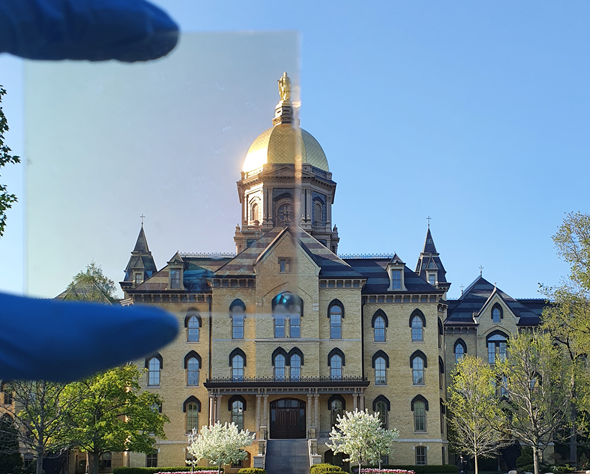Reviewed by Emily Henderson, B.Sc.Nov 3 2022
With climate change intensifying the summer heat, there is a great demand for cooling technologies for buildings. Currently, a team of researchers has used artificial intelligence (AI) and advanced computing technology to engineer a transparent window coating that is capable of lowering the temperature within buildings without even using a tiny amount of energy.
 This window film (held in fingers at top left) keeps rooms bright and cool by allowing visible light to pass in while reflecting invisible infrared and ultraviolet sunlight and radiating heat into outer space. Image Credit: Adapted from ACS Energy Letters 2022, DOI: 10.1021/acsenergylett.2c01969.
This window film (held in fingers at top left) keeps rooms bright and cool by allowing visible light to pass in while reflecting invisible infrared and ultraviolet sunlight and radiating heat into outer space. Image Credit: Adapted from ACS Energy Letters 2022, DOI: 10.1021/acsenergylett.2c01969.
Details of the new window coating have been illustrated in the journal ACS Energy Letters.
Previous studies have shown that cooling is the cause of approximately 15% of energy consumption worldwide. That energy demand can be reduced with a window coating that could obstruct the ultraviolet and near-infrared light of the sun—the constituents of the solar spectrum that normally pass through the glass to heat a room.
Energy use could be additionally minimized if the coating emits heat from the window’s surface at a wavelength that moves through the air into outer space.
However, it is challenging to develop materials that can match these criteria concurrently and can also convey visible light, meaning they do not obstruct the view. Tengfei Luo, Eungkyu Lee, and colleagues aimed to design a “transparent radiative cooler” (TRC) that could achieve just that.
The team built computer models of TRCs comprising alternating thin layers of regular materials such as silicon nitride, silicon dioxide, titanium dioxide, or aluminum oxide on a glass base, with a film of polydimethylsiloxane on top. They improved the type, order, and combination of layers using an iterative method directed by quantum computing and machine learning, which stores data using subatomic particles.
This computing technique performs optimization quicker and better than standard computers as it can efficiently test all probable combinations within a second. This formed a coating design that, when manufactured, outdid the performance of conventionally engineered TRCs as well as one of the top commercial heat-reduction glasses.
In hot, arid cities, the scientists explain, the improved TRC could potentially cut cooling energy consumption by 31% compared with traditional windows. They observe that their findings could be adapted to other applications as TRCs could also be applied to truck and car windows.
Furthermore, the team’s quantum computing-aided optimization method could be used to engineer other kinds of composite materials.
The National Research Foundation of Korea and the Notre Dame Center for Research Computing supported this study.
Journal Reference:
Kim, S., et al. (2022) High-Performance Transparent Radiative Cooler Designed by Quantum Computing. ACS Energy Letters. doi.org/10.1021/acsenergylett.2c01969.